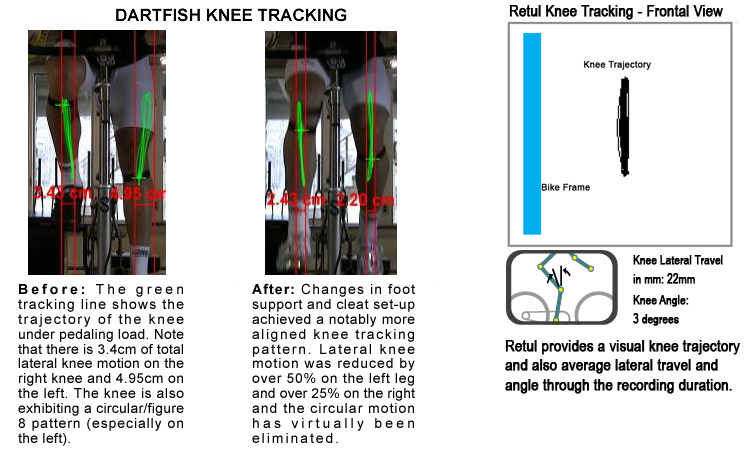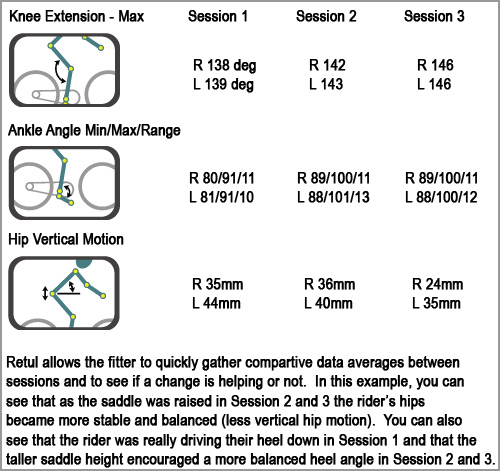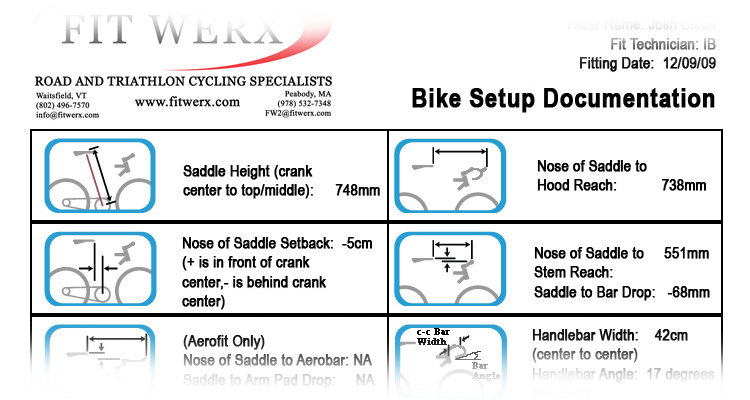Motion Capture & Analysis at Fit Werx
View a video that describes the steps of a professional fitting
As great as motion capture technology is, it is important for riders to understand what these systems can and cannot do and how that relates to the end result of your bike fitting. Below is a Q&A session about motion analysis systems and along with some examples of how the technology can be used to enhance a bike fit.
 Q) What is “motion capture and analysis”?
Q) What is “motion capture and analysis”?
A) In regards to cycling position, it is the act of digitally capturing a rider in motion and then using software to analyze the motions and alignment in key riding positions. Some systems record motion in 2D and others in 3D and each type has benefits and limitations.
Q) How do bike fitters use this information?
A) It depends on the fitter. Some fitters use motion capture to erase the individual human element. In this case “average” angles at specified key positions (bottom of the pedal stroke, for example) are used to determine riding position. Other fitters use it as an additional “bell or whistle” to increase the “Wow!” factor of their fittings. The most comprehensive fittings will combine manual and verbal assessments with dynamic fit and motion capture techniques. Fit Werx uses this final method as it embraces both the science and the art of fitting the best.
Q) Are there downsides to a motion capture fit?
A) Bicycle riding and bike fitting is a human activity. The risk of motion capture systems is that they can encourage a fitter to depend on computer generated angles to determine the end position at the expense of communication and technique assessment. When this happens, motion capture becomes little more than a high-tech (and expensive) version of the basic measurement and angle systems used for years by many formulaic “fit systems”. Like other formulaic systems, compromises will occur if technology is used as a substitute, instead of a supplement, for communication and individual analysis.
Q) Can an accurate fit now be done on-line with motion capture?
A) The most comprehensive fits are still face-to-face. The on-going dialogue between the fitter and the athlete, along with the increased accuracy of face-to-face assessment techniques, creates the most reliable end results. So, while motion capture can be used to get a more reliable result on-line than previous methods, on-line “fittings” are still more applicable as a basic sizing technique than a true comprehensive fitting. The knowledge and skill of the fitter and their protocols is still key to the quality of the end result regardless.
Q) How can motion analysis be used in a bike fitting?
A) There are a multitude of ways motion capture can be used in bike fitting. Right now, the technology is best suited to help the fitter see motion and capture data in ways we as humans cannot by slowing down the action and providing finite measurement, recording and tracking capabilities. Some examples:
Example 1: We want to see if a change in foot support has improved knee alignment. To do this, we use markers in combination with the motion analysis tool to compare the trajectory of the knee before the changes to the trajectory after.

Example 2: Maximum leg extension can occur in a different portion of the stroke for every rider and is affected by other variables beyond the knee (the hip and ankle dynamics, to name two). Motion capture can record the average maximum knee extension accurately over dozens of pedal strokes – providing a more accurate and realistic measurement than a static manual measurement where the rider is not pedaling. This example shows how Retul can be used by a fitter to capture data in different positions and quickly compare the results.

By combining this data with information gained in our initial interview and physical assessments, the position can be built accordingly to minimize joint load, maximize power transfer and encourage optimized pedaling technique. The result is a position that helps the rider reach their potential, while minimizing stress on the joints through greater accuracy.
Example 3: Motion analysis allows us to provide more accurate and easier to understand visual documentation of your position and technique. Our fittings include a flash drive that includes documentation of your riding position (example below), bike setup, and video based posture and technique analysis and recommendations.
In addition to these measurements, we offer detailed descriptions and images of where we measure in out Tech Center’s Mechanical Section under “Bike Setup/Measurements”.
Q) What motion capture systems is Fit Werx currently using and why?
A) Across our locations, we use two systems – Dartfish 2D and Retul 3D. Each system has different strengths and benefits as a fitting tool.
Dartfish is a 2D system that is not cycling specific and this is a benefit and a potential drawback. The benefit is that a fitter can turn Dartfish into just about anything they want. The drawback is that few fitters take the time to understand or build out Dartfish to its potential. When setup well, Dartfish is an impressive tool. Dartfish is a multi-camera based system (www.dartfish.com) and it is very visual and an excellent tool to help athletes see and understand their posture and technique through dynamic video feedback and assessment tools. Dartfish is also a very adjustable system, allowing tools and specific analysis to be built and executed on the spot. We use Dartfish’s Mediabook function to provide you with complete video based postural and technique documentation on a flash drive after your fitting.
Retul is a bike specific 3D system that uses LED technology and sensors to allow the fitter to record an incredible number of key angles and averages from a rider as they ride. Retul provides data quicker than Dartfish and also provides averages and minimum/maximum ranges very quickly. The benefit to Retul for many fitters is that it is “Plug and Play”, but the disadvantage for the rider is that the program can be used as a crutch instead of a tool by a fitter who does not understand the biomechanics behind bike fitting.
Retul’s standard rider and bike setup reports also benefit from a significant coding overhaul to make them understandable and applicable to the rider. Any Retul reports that we provide to you have been customized to make them easier to understand and more applicable to your fitting.
Fit Werx currently uses motion analysis in varying degrees in all of our fittings except the “Basic Sizing”.
